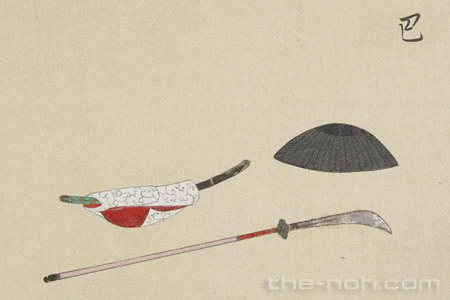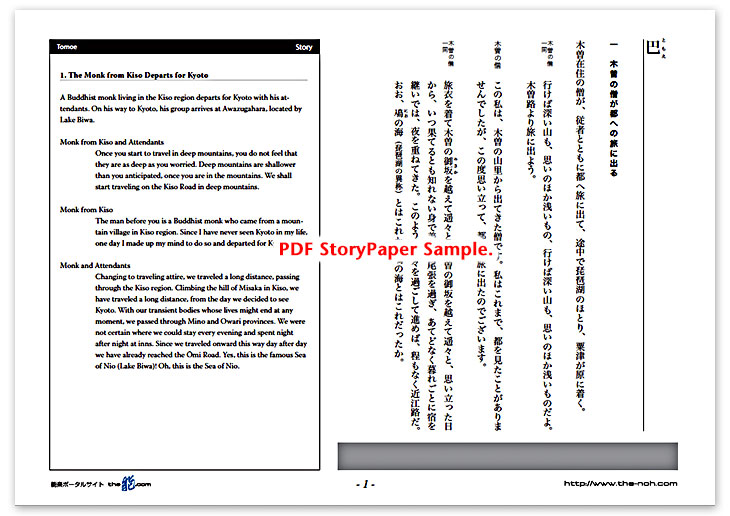
 Tomoe
Tomoe

![]()
When a Buddhist monk from Kiso passes through Awazugahara by Lake Biwa on his way to Kyoto, he encounters a woman who has come to pray at a shrine but is shedding tears. Thinking this is strange, the monk asks the reason why she cries. The woman cites an old poem to explain that it is not unusual to shed tears in front of deities, and as soon as she learns that the monk is from Kiso region, she tells him that the deity enshrined in Awazugahara is Kiso Yoshinaka (Minamoto no Yoshinaka, 1154-1184), who was a warlord of the Minamoto clan from the Kiso region and had distinguished achievements in the war. After she recommends the monk to commemorate Yoshinaka’s soul, she reveals that she is a ghost and disappears in the air.
The monk hears from a villager, who comes to pray, the story concerning Yoshinaka and Lady Tomoe. His story reinforces the belief that the woman the monk met was the ghost of Lady Tomoe.
That night, as he is chanting a Buddhist sutra for the deceased, the ghost of the woman appears in full armor. She informs him that she is the ghost of Lady Tomoe and says that she is obsessed by resentment because she could not die with her master Yoshinaka. She vividly describes the last moment of Yoshinaka and how she lived after his death. The ghost of Lady Tomoe then leaves after requesting the monk to pray to save her from the obsession.
![]()
When you hear about a woman who races across battlefields on horseback, you probably imagine a tough, brave female warrior. However, this Noh drama portrays Lady Tomoe as a woman who yearned for and loved her master, Kiso Yoshinaka, with all her heart and expressed her sincere love straightforwardly and earnestly. Although her power and toughness on the field of battle are overwhelming and even demonic, they rather emphasize her deep love for Yoshinaka.
This drama begins quietly and expresses things indirectly in the first half. The atmosphere however changes dramatically in the second half when the chorus mixes tsuyogin (‘strong song’ or powerful, louder chants) and yowagin (‘weak song’ or complicated and more melody-oriented chants) and alternates between fast and slow tempo in wonderful, widely diverse chanting. The shite, or leading actor, does not move ostentatiously in this drama. The shite does not perform any remarkable dances, except performing some special movements, but rather performs short, sophisticated movements, which embody the nature of Noh dramas. All of these movements passionately describe Lady Tomoe’s sorrowful fate and heart, and her various emotions vividly and poignantly touch the hearts of the audience.
It is interesting that in this piece, Tomoe always evokes tears regardless of the level of skill of the performer. Although the degree that the performance gets to your heart changes from actor to actor, the performances of a master, a youthful, developing performer, or an amateur Noh performer struggling to chant in suutai and rengin will all move the audience. Especially, if you learn how to chant and are able to chant this piece, you cannot help but feel the sorrow of Tomoe sharply within yourself. This is a truly powerful piece. It is therefore extremely fortunate if you encounter a performance of Tomoe performed by a skillful Noh master.
STORY PAPER : Tomoe
Story Paper presents noh chant stories in modern speech, with story outlines, highlights and more using Adobe PDF format, which can print out and zoom in. Print out the pages and take them with you when you see the actual noh performance.

The copyright of Story Paper is held by the Noh.com. Story Paper is for individual use only. It is prohibited by the copyright law to distribute or publish printed-out Story Paper pages without prior consent. For more information, check the credit and disclaimer pages.



 [Tomoe : Story Paper PDF : 453KB
[Tomoe : Story Paper PDF : 453KB